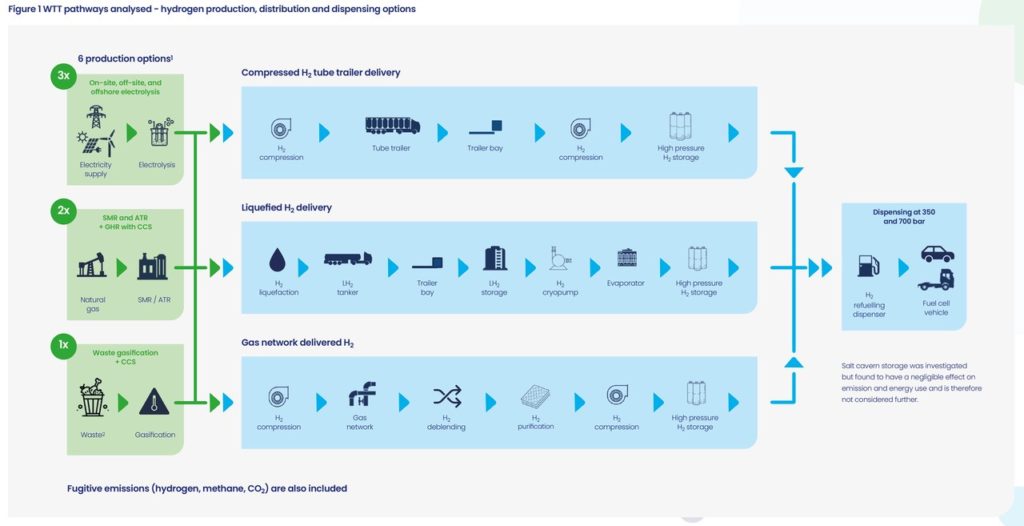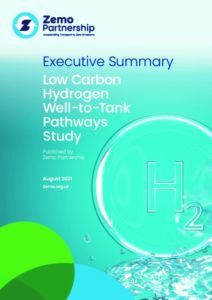The use of hydrogen for hard-to-electrify transport applications as well as a wide range of industrial and domestic heating, cooking and other applications is proposed by many advocates as a critical part of the solution to decarbonise the UK economy.
A new study and Well-to-Tank (WTT) model by Element Energy, commissioned by Zemo Partnership, identifies a range of pathways for the production, distribution and dispensing of low carbon hydrogen to transport end-users. It shows, in a high level of detail, the energy requirements and greenhouse gas emissions resulting from each potential pathway, as well as the infrastructure requirements related to each choice.
The research looks at a combination of six production configurations, three distribution pathways, and two dispensing options – a total of 32 potential pathway combinations.

It shows that fundamental choices exist in terms of the production of ‘green’ hydrogen using electrolysis powered by renewable electricity or ‘blue’ hydrogen, primarily produced by reforming fossil natural gas combined with CCS. It also looked at the implications of using biomethane in place of fossil gas and hydrogen derived entirely from biogenic waste.
The study also considers the energy use together with emissions arising along the full production, distribution and dispensing pathway, including unavoidable – or fugitive – emissions likely to arise during the process. It shows that there is a wide variation in the emissions associated with each of the alternative pathways, depending on the carbon footprint of the energy and feedstocks used.
The work suggests that renewables-based electrolysis is expected to represent one of the lowest emissions pathways in the medium-term. Natural gas reformation using emerging autothermal (ATR) technology with CCS could also significantly reduce emissions compared to current industrial steam methane reforming (SMR) process for so called ‘grey’ hydrogen. There are even potential pathways to generate carbon-negative hydrogen when biomethane is used, or through the gasification of waste, allied with CCS. (However, there are potential limitations on the future availability and supply of biomethane.)
While the study shows GHG emissions can be almost eliminated, improvements in the efficiency of the process of electrolysis are expected to contribute to a modest reduction in the energy intensity of this pathway in the medium-term. There are opportunities to co-locate hydrogen production with renewable energy, using surplus or currently curtailed energy at times of high production/low demand.
The research was informed by a steering group of industry and academic experts including Cadent Gas, Advanced Biofuel Solutions Ltd, Advanced Propulsion Centre, Shell, and the Universities of Bath, Brighton and Cambridge. The project was also supported by Scotland Gas Networks Plc, Southern Gas Network Plc, Northern Gas Networks, Wales and West Utilities.
 Gloria Esposito, Zemo Partnership’s Head of Sustainability, said: “Our work shows that hydrogen could be a key option but policy will need to incorporate full consideration of the energy consumed by low carbon fuel supply chains if we are to achieve future climate goals.”
Gloria Esposito, Zemo Partnership’s Head of Sustainability, said: “Our work shows that hydrogen could be a key option but policy will need to incorporate full consideration of the energy consumed by low carbon fuel supply chains if we are to achieve future climate goals.”
David Jones, Sustainable Transport Strategy Manager, Cadent Gas said, “The lowest-emissions and most energy efficient distribution pathway for hydrogen is transport by pipeline, whether green or blue.”
The study Executive Summary is available here and the full report here.



